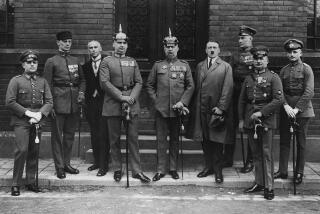‘The Tramp and the Dictator’: The Laugh Was on Hitler
During his heyday, Charlie Chaplin was one of the most beloved men in the world; Adolf Hitler was arguably the most hated figure of the 20th century. It seemed that there was little in common between the two men save for their little square mustaches. “The Tramp and the Dictator,” a new documentary from film historian and archivist Kevin Brownlow (“The Unknown Chaplin”), looks at the similarities and differences between these two men who were born within four days of one another in April 1889 and rose to fame during the early part of the century. The documentary, premiering Tuesday on Turner Classic Movies, kicks off a festival of 28 films and wartime cartoons that reflect how Hollywood portrayed the Nazis during World War II. Offerings include Chaplin’s restored 1940 classic “The Great Dictator,” in which the Little Tramp confronted the evil of Hitler’s Germany through laughter and tears. “The Tramp and the Dictator” also features recently unearthed behind-the-scenes color footage from “The Great Dictator”; interviews with historians, members of both men’s inner circle and Chaplin’s family members; and newsreels and clips from Chaplin’s films and Hitler’s propaganda films. The Chaplin family contacted Brownlow after two of the actor’s children, Christopher and Vicki, found the color footage of “The Great Dictator” in a suitcase in the basement of their family home in Switzerland. Chaplin’s brother, Sydney, had shot the footage. Brownlow and his producer, Patrick Stanbury, went over to Paris to look at the footage. “I felt at once as fascinating though it was, it wasn’t revealing enough to carry a 50-minute documentary,” says Brownlow. He didn’t think any more about it until his German counterpart, Michael Kloft, rang him up about the footage. “He said why don’t we do it as a portrait of Chaplin and Hitler?” recalls Brownlow. “That was the clue--then you could do it.” The documentary reveals that Hollywood was afraid in the late ‘30s to upset the Nazis and was careful to excise anything anti-Third Reich from scripts. Part of the reason for their resistance to make anything critical toward Hitler was the fact that Hollywood didn’t want to lose the lucrative German film market--Hollywood exported movies to the country until 1941. More importantly, Brownlow asserts, Hollywood feared repercussions against Jews left in Germany. So when Chaplin decided to make “The Great Dictator” in 1939, before Hitler invaded Poland, Brownlow says Hollywood was “desperate to stop him. One can understand that.” Even after Chaplin made the film with his own money, the studio chiefs didn’t want it released. Finally, says son Sydney Chaplin, it was President Roosevelt who stepped in. “My father didn’t like Hitler at all,” recalls Chaplin. “He thought he was pompous and ridiculous. But we weren’t at war. He finally had to get permission to release the picture from President Roosevelt. Roosevelt said that this man should be ridiculed.” In the satire, Chaplin plays a Jewish barber trying to survive in the Jewish ghetto of Tomania under the look-alike dictator of the country, the pompous Adenoid Hynkel, who is planning to invade the country of Osterlich. Jack Oakie plays the equally bombastic Napolani, the dictator of Bacteria (and a stand-in for Mussolini). Paulette Goddard, then married to Chaplin, plays the barber’s love interest, Hannah. “Great Dictator” boasts many classic scenes, including Hynkel’s ballet with a globe and his stirring anti-fascist speech at the film’s conclusion. Brownlow says that Chaplin actually put his life on the line making the film. “The number of political assassinations by Hitler and Stalin at that time was enough to worry someone of his importance,” says Brownlow. “Trotsky had been assassinated in 1940 and Chaplin might well have been killed in California. He could have been quietly shot.” Though Hitler hated Chaplin, says Brownlow, because the dictator thought he was a Jew, he loved American films and even graded them in his notebooks. Greta Garbo, for example, was one of his favorites. “But he didn’t like ‘Tarzan,’ ” says Brownlow. “He loved ‘The Lives of a Bengal Lancer.’ ” The jury is still out on whether Hitler ever saw “The Great Dictator.” Co-director Kloft was able to track down a member of Hitler’s inner circle who says it is likely the Fuehrer did screen the film. Nazi propagandist Joseph Goebbels “has said in his diaries that Hitler concentrated on newsreels once the war began, but I cannot believe that; the temptation would be too great,” Brownlow says. “The Great Dictator” marked the silent comedian’s first foray into talkies. Ironically, Hitler never came across well in silent films. Brownlow says it was only after sound came in and he took acting lessons that he became so powerful and dramatic in front of the cameras. Sydney Chaplin says since the 1930s he’s heard stories that Hitler adapted the Little Tramp mustache because his father was so popular. Brownlow disagrees with that theory. “If you think about it, Hitler loathed Chaplin because he thought he was Jew. So why would he adopt the mustache? People said he adopted the mustache to soften his personality and to look like the best-loved man in the world, but he wouldn’t want to look like a comedian. It was a style adopted by many military men in Germany at that period.” Chaplin has said that if he had known just how insidious Hitler and the Nazi regime were, he never would have made “Great Dictator.” “I think it made everyone sick when the truth came out,” says Brownlow. “Comedy was impossible once that had happened.” The film, though, helped audiences cope with the horrors of World War II. “In England, it was so successful that every cinema in a town would be running it,” says Brownlow. “It was a godsend in England during the blitz.” “The Tramp and the Dictator” can be seen Tuesday at 5 and 8:30 p.m. on TCM; “The Great Dictator” is at 6 p.m.; “To Be or Not to Be” follows at 9:30 p.m.; “Confessions of a Nazi Spy” at 11:15 p.m.; “The Mortal Storm” at 1 a.m. and “Foreign Correspondent” at 3 a.m. The “Hollywood Takes on the Nazis” festival continues every Tuesday through October.
More to Read
Only good movies
Get the Indie Focus newsletter, Mark Olsen's weekly guide to the world of cinema.
You may occasionally receive promotional content from the Los Angeles Times.










